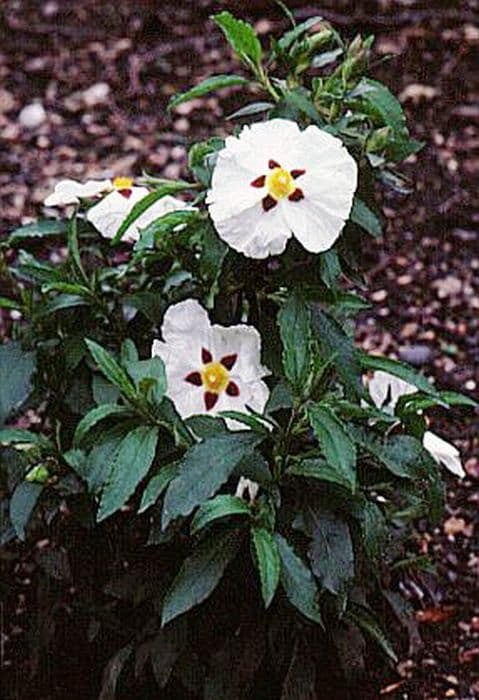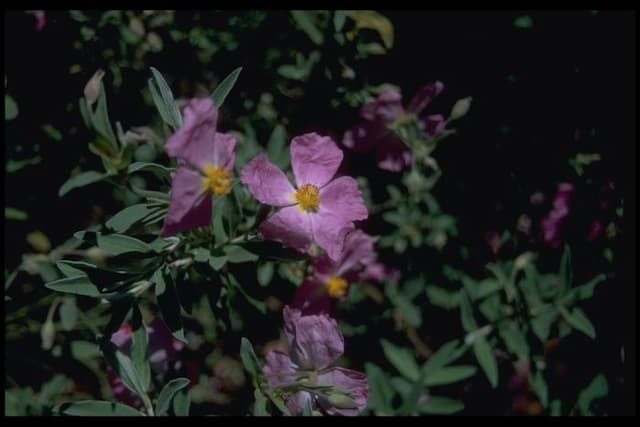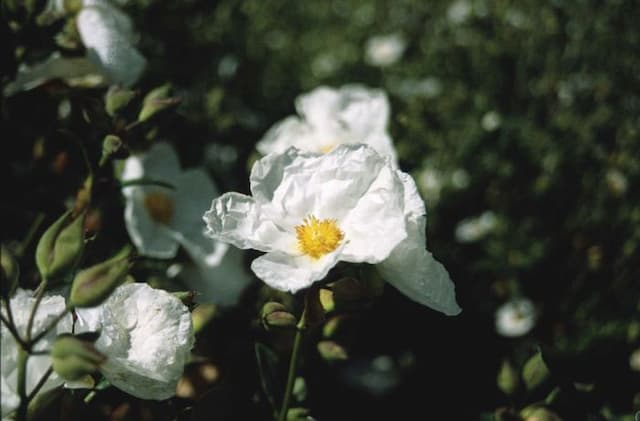Cyprian Rock Rose Cistus × cyprius

ABOUT
The rockrose, with its botanical relation to the island of Cyprus, is a flowering plant known for its showy and decorative appearance. It bears large, white flowers which often have a crinkled texture, much like crepe paper, and each petal is generally adorned with a yellow spot at the base, providing a splash of vibrant color. These blooms are especially known for their showy display, resembling wild roses, and their presence is a highlight in any garden with their bright and attractive aesthetic. The flowers are solitary on the stems, adding a touch of elegance to the overall appearance of the plant. The leaves of the rockrose are dark green, leathery to the touch, and often have a sticky surface, glistening as if varnished. They are lance-shaped, providing a striking contrast against the delicate flowers. The overall appearance of the rockrose is of a lush and robust plant that can bring a sense of Mediterranean charm to a landscape with its radiant blooms and rich, evergreen foliage.
About this plant
 Names
NamesFamily
Cistaceae
Synonyms
Cyprian Rockrose, Cyprus Rockrose
Common names
Cistus × cyprius.
 Toxicity
ToxicityTo humans
The Cistus × cyprius, commonly known as the Cyprian rockrose, is not documented to be toxic to humans. There are no well-known adverse effects or symptoms of poisoning reported for this plant upon ingestion. However, as with any plant material, individual allergies and sensitivity can vary, and it's always prudent to exercise caution and avoid ingesting plants not known to be edible.
To pets
Similarly, the Cyprian rockrose is not known to be toxic to pets. There is no specific documentation of this plant causing poisoning in animals like cats and dogs. Despite the lack of reported toxicity, pet owners should still prevent pets from ingesting plants indiscriminately, as individual reactions can vary, and some pets might experience gastrointestinal upset or other issues if they consume plant matter they are not accustomed to.
 Characteristics
CharacteristicsLife cycle
Perennials
Foliage type
Evergreen
Color of leaves
Green
Flower color
White
Height
5 feet (1.5 meters)
Spread
5 feet (1.5 meters)
Plant type
Shrub
Hardiness zones
8
Native area
Mediterranean
Benefits
 General Benefits
General Benefits- Landscape Ornamentation: Cistus × cyprius, commonly known as the Cyprian rockrose, adds aesthetic value to gardens with its showy, pink-white flowers and lush green foliage.
- Drought Tolerance: As a Mediterranean plant, the Cyprian rockrose is highly tolerant of dry conditions, making it suitable for xeriscaping.
- Low Maintenance: This plant requires minimal care once established, needing little watering or pruning, which can save time and resources.
- Erosion Control: The Cyprian rockrose can help stabilize soil and prevent erosion with its extensive root system, particularly on slopes and in dry regions.
- Wildlife Attraction: The plant can attract pollinators such as bees and butterflies, contributing to the biodiversity of the garden ecosystem.
 Medical Properties
Medical Properties- Antioxidant: Cistus × cyprius contains polyphenolic compounds which exhibit antioxidant properties.
- Antimicrobial: Extracts of the plant have been documented to have antibacterial and antifungal effects.
- Anti-inflammatory: The plant has been traditionally used to reduce inflammation in various conditions.
- Astringent: Cistus × cyprius has been used for its astringent properties to assist with wound healing and skin conditions.
- Respiratory health: Traditionally used to alleviate respiratory conditions like coughs and colds.
 Air-purifying Qualities
Air-purifying QualitiesThis plant is not specifically known for air purifying qualities.
 Other Uses
Other Uses- Perfume Industry: Cistus × cyprius, commonly known as Rockrose, is a significant source of labdanum, a resin used in perfumes to provide a warm, ambergris-like fragrance.
- Landscape Gardening: Due to its attractive flowers and low maintenance, Rockrose is often used in xeriscaping and as ornamental shrubs in Mediterranean-style gardens.
- Erosion Control: The dense growth habit of Rockrose helps stabilize the soil and is beneficial for hillside planting and erosion control measures.
- Firebreaks: Rockrose plants are sometimes included in firebreaks due to their ability to recover quickly after a fire, thus providing a vegetative barrier to wildfires.
- Beekeeping: Rockrose provides a rich source of nectar and pollen for bees, making it an excellent plant for supporting local bee populations and honey production.
- Dye Production: The plant can be used to produce a natural dye, although this is less common due to the availability of synthetic alternatives.
- Symbolism: In some cultures, Rockrose is used in floral arrangements to symbolize survival and resilience because of its ability to thrive in challenging conditions.
- Essential Oils: Aside from its use in perfumery, the oil extracted from Rockrose is incorporated into a variety of aromatherapy products for its soothing scent.
- Artisan Crafts: The resin collected from Rockrose, labdanum, can be used as an adhesive or ingredient in the creation of traditional incense and aromatic crafts.
- Scent Layering in Gardens: The strong scent of Rockrose makes it ideal for planting alongside other aromatic herbs in a garden setting to create a complex and layered fragrance experience.
Interesting Facts
 Feng Shui
Feng ShuiThe Rockrose is not used in Feng Shui practice.
 Zodiac Sign Compitability
Zodiac Sign CompitabilityThe Rockrose is not used in astrology practice.
 Plant Symbolism
Plant Symbolism- Resilience: Often grown in tough, Mediterranean climates, Cistus × cyprius, commonly known as Rockrose, symbolizes the ability to persist and thrive in the face of challenging conditions.
- Beauty in Simplicity: With its simple yet stunning flowers, the Rockrose represents the beauty in simplicity and a reminder that elegance can be found in modesty.
- Healing: Rockrose has been used in traditional medicine, and as such, it symbolizes healing and therapeutics, both physical and emotional.
- Passing Nature of Life: The flowers of the Rockrose often last only a day, symbolizing the fleeting nature of life and the importance of living in the present moment.
- Renewal: As a plant that can regenerate after fires, the Rockrose stands for renewal and the ability to rise from adversity.
 Water
WaterRockrose plants, including Cistus × cyprius, should be watered moderately. These plants are drought-tolerant once established, but they will require regular watering during their first growing season to develop a deep root system. Water rock roses about once a week, providing about 1-2 gallons of water per plant each time, depending upon the soil and climate conditions. Ensure that the soil is well-drained and that you are not overwatering, as rockrose plants do not like wet feet. After the first year, you can reduce watering frequency, only supplying water during prolonged dry spells.
 Light
LightRockrose plants, like Cistus × cyprius, thrive in full sun conditions. They perform best when planted in a location that receives at least six to eight hours of direct sunlight each day. A spot that offers unfiltered, bright light will promote the best flowering and growth habits. Avoid planting rockrose in areas with heavy shade, as this can adversely affect the plant's blooming and overall health.
 Temperature
TemperatureRockrose plants, including Cistus × cyprius, prefer a warm climate and are tolerant to varying temperatures. They can survive in temperatures as low as 15 degrees Fahrenheit but may experience damage below this point. The ideal temperature range for rockrose plants is between 50 to 75 degrees Fahrenheit. They are adaptable to higher temperatures typical of Mediterranean and similar climates.
 Pruning
PruningCistus × cyprius, commonly known as rockrose, benefits from occasional pruning to maintain shape and remove dead or damaged branches. Pruning is best done shortly after the flowering season ends, usually in late spring or early summer. Do not prune too late in the year, as this can stimulate new growth that might be vulnerable to frost. Pruning every year or every other year can help to rejuvenate the plant and encourage a fuller, more compact growth habit.
 Cleaning
CleaningAs needed
 Soil
SoilThe ideal soil mix for Cistus, commonly known as Rockrose, should be well-draining with a mixture of loam, sand, and peat, and should have a slightly acidic to neutral pH of 6.0 to 7.5 to thrive.
 Repotting
RepottingRockrose plants typically do not require frequent repotting and can be repotted every two to three years as they prefer to be slightly root-bound and have a slow growth rate.
 Humidity & Misting
Humidity & MistingRockrose plants are adapted to dry conditions and prefer a low to moderate humidity level, making them quite tolerant to the typical humidity found in most homes.
 Suitable locations
Suitable locationsIndoor
Place Rockrose in bright light, away from drafts, with minimal watering.
Outdoor
Plant Rockrose in full sun, well-drained soil, and shelter from harsh winds.
Hardiness zone
Rockrose is suitable for USDA zones 8-11.
 Life cycle
Life cycleCistus × cyprius, commonly known as the Cyprus rockrose, begins its life as a seed that germinates in warm, moist soil conditions, typically in the spring. After germination, the seedling emerges and develops its first leaves, entering the vegetative growth stage where it focuses on root and foliage development. Once the plant reaches maturity, it goes through a flowering stage, usually in late spring to early summer, producing white to pink flowers with a distinctive maroon spot at the base of each petal. After pollination, often by insects, the flowers develop into capsules that contain numerous tiny seeds. These seeds, once matured, are dispersed by wind or wildlife, completing the reproductive cycle. The Cyprus rockrose is a perennial plant, and this cycle can repeat for several years, with the plant growing larger and more robust over time.
 Propogation
PropogationPropogation time
Spring to Summer
Propogation: Rockrose, also known as Cistus × cyprius, is most commonly propagated through semi-hardwood cuttings. This method is usually done in late summer. Cuttings of about 4-6 inches long are taken from the current year's growth ensuring that each cutting has several leaves. The lower leaves are removed and the cut end dipped in rooting hormone to encourage root growth. The cuttings are then placed in a well-draining potting mix, such as a combination of peat and perlite, and kept under high humidity and indirect light until they root, which typically takes several weeks. The soil should be kept moist but not waterlogged to prevent rot. Once the cuttings have established a robust root system, they can be transplanted to their final location.









